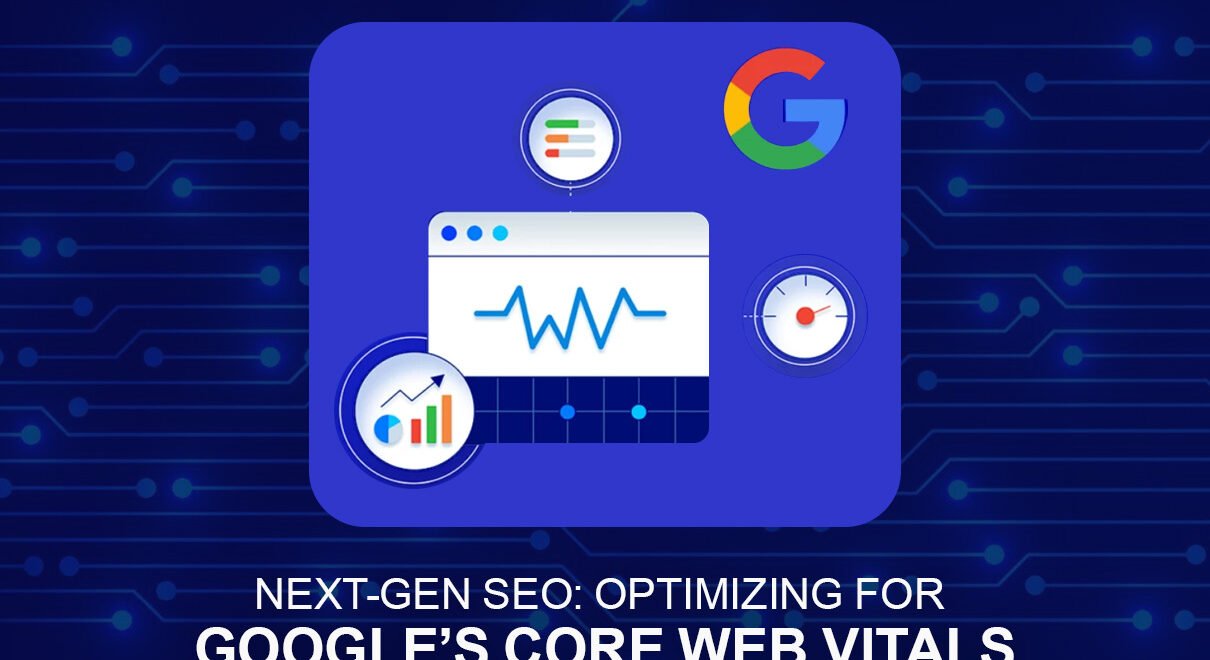Introduction to Core Web Vitals
Core Web Vitals are a set of specific factors that Google considers essential for providing a good user experience on websites. These metrics have gained significant importance in modern SEO practices, with a clear focus on enhancing the overall user journey. As the online landscape continues to evolve, understanding Core Web Vitals is pivotal for anyone seeking to optimize their website’s performance.
The three essential metrics that make up Core Web Vitals include Largest Contentful Paint (LCP), First Input Delay (FID), and Cumulative Layout Shift (CLS). Each of these metrics focuses on different aspects of user experience. LCP measures loading performance, specifically how long it takes for the largest element on the page—typically an image or a block of text—to become visible to the user. A good LCP score is considered to be under 2.5 seconds.
First Input Delay, or FID, gauges interactivity by measuring the time it takes for a website to respond to user interactions, such as clicks or taps. A low FID score indicates that users can engage with the page almost immediately, ideally registering at less than 100 milliseconds. Meanwhile, Cumulative Layout Shift evaluates visual stability, capturing how much visible content shifts on the screen unexpectedly while it loads. An acceptable CLS score is below 0.1, ensuring that users are not disrupted by sudden layout changes.
These metrics are measured using various tools and techniques, including Google’s PageSpeed Insights, Lighthouse, and the Chrome User Experience Report. By focusing on Core Web Vitals, website owners can enhance their SEO strategy, ultimately improving site rankings and user satisfaction, which is crucial in a highly competitive digital environment.
Why Core Web Vitals Matter for SEO
In recent years, Google has increasingly emphasized the importance of user experience as a critical component of search engine optimization (SEO). Central to this evaluation are the Core Web Vitals, which consist of three key metrics: Largest Contentful Paint (LCP), First Input Delay (FID), and Cumulative Layout Shift (CLS). These metrics provide insight into how users perceive the performance of a webpage, making them essential for website owners and SEO professionals to understand and optimize.
The Largest Contentful Paint measures loading performance, focusing on how quickly the main content of a page becomes visible to users. A slow LCP can lead to user frustration and increased bounce rates, negatively impacting a site’s search rankings. Similarly, First Input Delay assesses interactivity, quantifying the time it takes for a page to respond to a user’s first action. Pages that respond quickly tend to create a more positive user experience, which Google recognizes in its ranking algorithms. Lastly, Cumulative Layout Shift evaluates visual stability by measuring unexpected shifts in content, which can be disruptive and lead to poor user experiences.
Google has integrated these Core Web Vitals into its page experience ranking criteria, which means that websites meeting or exceeding the recommended thresholds for these metrics are more likely to achieve higher positions in search results. This shift underscores the necessity for website owners to prioritize loading speed, interactivity, and visual stability when developing or optimizing their sites. Failure to do so may result in decreased visibility, reduced traffic, and ultimately, lower conversion rates.
By focusing on these metrics, website owners and SEO professionals can align their strategies with Google’s expectations, enhancing user satisfaction and site performance. In this digital landscape, integrating Core Web Vitals into an SEO framework is no longer optional but a vital component of any successful optimization strategy.
Analyzing Your Current Performance
In order to optimize your website for Google’s Core Web Vitals, it is essential first to assess its current performance. Evaluating the aspects of user experience filtered through Core Web Vitals is key to understanding how your site is perceived by both users and search engines. There are several tools available that can help you accomplish this task effectively.
One of the most commonly used resources is Google PageSpeed Insights. This tool provides a snapshot of your website’s performance, focusing on three critical metrics: Largest Contentful Paint (LCP), First Input Delay (FID), and Cumulative Layout Shift (CLS). By analyzing the results presented in PageSpeed Insights, you can gain insights into load times, responsiveness, and visual stability, which are vital for enhancing user experience.
Another powerful resource is Lighthouse, which is an open-source, automated tool for improving the quality of web pages. It runs a series of audits on your site, ultimately providing a report that includes Core Web Vitals metrics. Lighthouse can identify specific areas of your website that need improvement, such as image optimization or JavaScript execution times, allowing you to prioritize your efforts strategically.
Additionally, using the Chrome User Experience Report can offer real-world data on how your website performs in the wild. This data includes information gathered from actual users, providing a deeper understanding of the user experience. Utilizing these various tools gives you a comprehensive view of your site’s current status regarding Core Web Vitals. By systematically analyzing the gathered data, you will be equipped to make informed decisions on improvements needed to enhance your website’s performance and user experience.
Optimizing LCP – Largest Contentful Paint
One of the critical components in enhancing your website’s performance is improving the Largest Contentful Paint (LCP) metric. This metric significantly affects user experience as it measures the time it takes for the largest visible content element to load on a web page. To optimize LCP effectively, several strategies can be implemented.
Firstly, focusing on image optimization is vital. Large images are often the main contributors to slow loading times. By compressing images appropriately without sacrificing quality, you can significantly reduce loading times. Employing modern formats such as WebP can also help, as these formats typically provide superior compression rates compared to traditional formats like JPEG or PNG.
Additionally, implementing lazy loading is another effective strategy. Lazy loading defers the loading of images and other non-essential resources until they are needed, which means that only the visible content on the web page is loaded immediately. This practice can dramatically enhance perceived loading speeds and improve the LCP score, thereby contributing positively to user engagement.
Server response times play a crucial role in LCP. Website owners should aim to utilize fast and reliable hosting solutions. Consider employing Content Delivery Networks (CDNs) to deliver content from locations closer to the users, thus reducing latency. Improving the server response time itself by optimizing the back-end code can also contribute to a quicker load of the primary content.
Lastly, reducing render-blocking resources is essential for optimizing load times. This entails minimizing the use of unnecessary JavaScript and CSS that can delay the rendering of the main content. By using asynchronous loading for JavaScript files and ensuring that CSS is efficiently structured and minimized, you can enhance the overall loading experience.
By incorporating these best practices, webmasters can significantly improve their LCP metrics, leading to enhanced user satisfaction and potentially better search performance.
Enhancing FID – First Input Delay
First Input Delay (FID) is a core web vital metric that measures the responsiveness of a webpage, specifically focusing on the time it takes for a browser to respond to user interactions. Optimizing FID is crucial as it directly impacts the user experience and can influence search engine rankings. To enhance FID, several techniques can be employed, particularly revolving around optimizing JavaScript execution, leveraging web workers, and eliminating unnecessary code.
One effective way to minimize FID is by optimizing the execution of JavaScript. This can be achieved by identifying and deferring non-essential scripts which inevitably block the main thread, slowing down the responsiveness of a webpage. By loading scripts asynchronously, developers can ensure that necessary resources are prioritized without hindering the user’s ability to interact with the page. This streamlined approach allows browsers to respond to user inputs much quicker, thus contributing positively to the FID metric.
Additionally, utilizing web workers is another potent method to improve FID. Web workers allow scripts to run in the background, separate from the main thread, which means that complex calculations or fetch requests can be processed without affecting the responsiveness of the user interface. This results in a more fluid user experience, as the main thread remains available to handle user interactions promptly.
Finally, eliminating unnecessary code is vital for enhancing FID. Code bloat can lead to prolonged loading times and increased delays in user interactivity. By auditing and removing redundant scripts, optimizing CSS, and employing tree shaking techniques, web developers can create leaner, more efficient websites. Prioritizing essential features and functions will ensure that users experience minimal delays when interacting with the site, which directly improves the FID metric.
Reducing CLS – Cumulative Layout Shift
The Cumulative Layout Shift (CLS) is a crucial metric in Google’s Core Web Vitals that reflects the stability of a web page’s visual layout. A high CLS score can lead to a frustrating user experience, as unexpected layout shifts may cause accidental clicks and disorientation. To minimize CLS, several strategies can be implemented that focus on establishing a stable layout for users as they navigate through the content.
One effective approach is to define size attributes for images and videos. By explicitly setting the width and height of these media elements, the browser can reserve the necessary space for them, preventing shifts as the content loads. For example, if an image’s dimensions are specified, the page layout can remain intact, and the visual flow will be less likely to be disrupted. This practice extends to all forms of media, including iframes and other embedded resources.
Additionally, it is essential to avoid inserting new content above existing content, especially during the loading phase. This common mistake occurs when advertisements, pop-ups, or dynamically loaded content appear in a manner that alters the layout. Instead, developers should aim to load such elements below the main content or utilize placeholders to maintain a consistent layout during loading. This proactive approach allows users to engage with the content without interruption.
Lastly, employing CSS techniques can further stabilize layout shifts. Utilizing properties such as ‘min-height’ or ‘max-height’ for elements helps control how much space they occupy during active loading periods. Moreover, employing CSS Grid or Flexbox can facilitate a more responsive design that is inherently less prone to layout shifts. By integrating these strategies into the web design process, developers can create seamless experiences that significantly improve the CLS score, ultimately enhancing overall user satisfaction.
Testing and Monitoring Your Improvements
Once you have implemented optimization strategies aimed at enhancing Google’s Core Web Vitals, the next crucial step is to continuously test and monitor your website’s performance. This ongoing evaluation is essential in ensuring that the enhancements yield the desired results and maintain optimal functionality as the web ecosystem evolves.
One of the most effective tools for tracking your Core Web Vitals performance is Google’s PageSpeed Insights. This tool provides insights into loading performance, interactivity, and visual stability. By inputting your website’s URL, you can receive a detailed report that highlights areas where improvements can be achieved. Additionally, using tools like Lighthouse, which is integrated into Chrome DevTools, can provide an in-depth analysis of your site’s performance, helping you identify weak spots that need addressing.
Another valuable resource is the Google Search Console, which offers a Core Web Vitals report that showcases how your URLs perform in real-world conditions. This report can be instrumental in identifying any discrepancies between your testing scenarios and actual user experiences. Furthermore, implementing monitoring services such as GTmetrix, Pingdom, or WebPageTest can aid you in regularly benchmarking your site’s performance against competitors and industry standards.
It’s important to note that continuous improvements should be guided by data-driven insights. As you gather performance data from these tools, you can adjust your optimization tactics, whether that involves enhancing server response times, optimizing images, or minimizing render-blocking resources. The key is to remain responsive to the feedback and adaptable in your strategies, ensuring that your website continues to meet the high standards set by Google’s Core Web Vitals.
By maintaining a cycle of testing, monitoring, and adjusting based on performance data, you can ensure that your website delivers an exceptional user experience while aligning with Google’s evolving ranking criteria.
Common Pitfalls to Avoid
When venturing into the optimization of Core Web Vitals, it is essential to be aware of common pitfalls that can hinder your website’s performance and overall user experience. One prevalent mistake is over-optimization. While it may be tempting to focus solely on improving specific metrics such as Largest Contentful Paint (LCP) or First Input Delay (FID), prioritizing these indicators to the detriment of other aspects of the website can lead to an unbalanced user experience. Ensuring that performance enhancements do not sacrifice essential design or content elements is vital for maintaining user engagement.
Another critical error is neglecting user experience in favor of speed. Many website owners mistakenly believe that speed is the only factor that influences Core Web Vitals. While it remains an important determinant, delivering valuable content and an intuitive navigation experience is equally crucial. Striving for faster load times should not come at the cost of clear layout and accessible information. Hence, providing users with contextually relevant and high-quality content should be prioritized alongside efforts to optimize speed.
Additionally, ignoring mobile optimization is a significant oversight in the context of Core Web Vitals. With mobile devices accounting for a substantial portion of web traffic, it is imperative to ensure that your website performs well on these platforms. Many businesses mistakenly focus their optimizations solely on desktop experiences, consequently disregarding mobile-specific issues such as clickability and mobile viewport sizing. To mitigate this risk, implement responsive design principles and optimize interface elements for mobile users to provide a seamless experience across device types.
By recognizing and addressing these common pitfalls, website owners can create a balanced approach to their SEO strategy, focusing on Core Web Vitals while also enhancing the overall user experience.
Future Trends in SEO and Core Web Vitals
As we advance into a digital landscape increasingly dominated by user experience, the significance of Core Web Vitals within SEO strategies cannot be overstated. Core Web Vitals are essential metrics that reflect the performance of a website concerning user engagement, load times, and interactivity. The ongoing evolution of web technology will indubitably bring about substantial trends affecting how businesses optimize their online presence.
One prominent trend is the rise of artificial intelligence and machine learning. These technologies are becoming integral in analyzing user behavior and predicting engagement patterns. Websites that can leverage AI to create personalized experiences will likely outperform competitors in achieving higher rankings. This is especially relevant as users’ expectations have changed drastically in a post-pandemic world, where immediacy and seamless interaction have become critical.
Additionally, with the increasing utilization of mobile devices, optimizing for Core Web Vitals across various platforms is essential. Mobile-first indexing, which Google has adopted, means that website performance on mobile devices is more crucial than ever. Businesses must ensure that their websites meet the demands of mobile users, who increasingly prioritize fast-loading, responsive sites over slower alternatives.
Changes in user behavior, notably due to the pandemic, have shifted the focus toward more dynamic content interactions. Users now expect websites to not only load quickly but also provide engaging and interactive content. Understanding this shift will be crucial for marketers and web developers aiming to enhance their Core Web Vitals.
Moreover, Google’s continuous updates to its algorithms suggest that staying informed about SEO trends related to Core Web Vitals is imperative for any digital strategy. Regular assessments and adjustments based on the latest metrics will help businesses maintain their competitive edge. As the digital landscape continues to evolve, adapting to these trends will be vital for sustained performance and visibility in search engine results.







